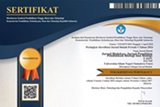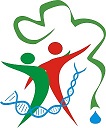Characterization of marine bacteria isolates GaN 2 and RaN 2 from Papuma Coastal, Jember
Abstract
The exploration of secondary metabolites for various human needs has now extended to aquatic environments. The fluctuating and dynamic nature of aquatic environments can stimulate marine bacteria to adapt by producing secondary metabolites. The diversity of marine bacteria has become increasingly promising as a target for obtaining various potential secondary metabolites. This study aims to isolate potential marine bacteria that produce secondary metabolites from the Papuma Beach area in Jember. Marine bacterial characterization can be carried out through morphological and molecular approaches. In this study, bacterial isolates were collected from marine algae at aquatic sites. Bacteria were isolated from the algae using the spread plate and streak plate methods on nutrient agar dissolved in artificial seawater as the medium until single colonies were obtained. Morphological characterization of the single colonies was conducted by observing colony shape and color, as well as performing Gram staining. Molecular characterization of selected single colonies was performed by amplifying the 16S rDNA as a bacterial molecular marker. The results of this study showed that marine bacteria that grew well and remained stable on artificial media were successfully isolated from green and red algae samples, labeled GaN 2 and RaN 2, respectively. The GaN 2 bacterial isolate was identified as Fictibacillus barbaricus strain SQ5-4, while the RaN 2 bacterial isolate was identified as Bacillus altitudinis strain 41KF2bT.26. According to previous studies, Fictibacillus barbaricus is known to have potential as a bioremediation agent, while Bacillus altitudinis has potential applications as an antitumor, antimicrobial, and antioxidant-producing agent.
Keywords
Full Text:
PDFReferences
Akihary, C. V., & Kolondam, B. J. (2020). Pemanfaatan gen 16s rRNA sebagai perangkat identifikasi bakteri untuk penelitian-penelitian di indonesia. Pharmacon, 9(1), 16-22. https://doi.org/10.35799/pha.9.2020.27405
Amankwah, F. K. D., Gbedema, S. Y., Boakye, Y. D., Bayor, M. T., & Boamah, V. E. (2022). Antimicrobial potential of extract from a Pseudomonas aeruginosa isolate. Scientifica, 2022, 4230397. https://doi.org/10.1155/2022/4230397
Amatullah, L. H., Afifah, D. N., & Jannah, S. N. (2023). Isolation and molecular identification of proteolytic bacteria from rusip an Indonesian fermented food. Biosaintifika: Journal of Biology & Biology Education, 15(3), 450-459. http://dx.doi.org/10.15294/biosaintifika.v15i3.42237
Anteneh, Y. S., Yang, Q., Brown, M. H., & Franco, C. M. M. (2021). Antimicrobial activities of marine sponge-associated bacteria. Microorganisms, 9(1), 171. https://doi.org/10.3390/microorganisms9010171
Church, D. L., Cerutti, L., Gürtler, A., Griener, T., Zelazny, A., & Emler, S. (2020). Performance and application of 16S rRNA gene cycle sequencing for routine identification of bacteria in the clinical microbiology laboratory. Clinical Microbiology Reviews, 33(4), e00053-19. https://doi.org/10.1128/CMR.00053-19
Couto, C. R. de A., Alvarez, V. M., Marques, J. M., Jurelevicius, D. de A., & Seldin, L. (2015). Exploiting the aerobic endospore-forming bacterial diversity in saline and hypersaline environments for biosurfactant production. BMC Microbiology, 15(1), 240. https://doi.org/10.1186/s12866-015-0575-5
Djoemharsjah, I. S., Ambarwati, R., & Rahayu, D. A. (2023). DNA barcoding Clithon sp. (Gastropoda: Neritidae) from Badur Beach, Madura, Indonesia, based on COI gene molecular marker. Biodiversitas Journal of Biological Diversity, 24(5), 2779-2787. https://doi.org/10.13057/biodiv/d240531
Dongare, P. N., Motule, A. S., More, M. P., Patinge, P. A., & Bakal, R. (2020). An overview on anticancer drugs from marine source. World Journal of Pharmaceutical Research, 10(1), 950–956.
Fitrian, T., & Madduppa, H. (2020). Penentuan jenis ikan layang (Decapterus macrosoma) menggunakan metode analisis morfologi dan dna barcoding dari pasar ikan muara baru jakarta utara. Bawal Widya Riset Perikanan Tangkap, 12(3), 127–135.
Fu, X., Gong, L., Liu, Y., Lai, Q., Li, G., & Shao, Z. (2021). Bacillus pumilus group comparative genomics: toward pangenome features, diversity, and marine environmental adaptation. Frontiers in Microbiology, 12(571212), 1-16. https://doi.org/10.3389/fmicb.2021.571212
Fukuda, K., Ogawa, M., Taniguchi, H., & Saito, M. (2016). Molecular approaches to studying microbial communities: Targeting the 16S Ribosomal RNA gene. Journal of UOEH, 38(3), 223–232. https://doi.org/10.7888/juoeh.38.223
Gaffar, S., & Sumarlin, S. (2021). Analisis sekuen mtDNA COI Pari totol biru yang didaratkan di tempat pendaratan ikan kota Tarakan. Jurnal Harpodon Borneo, 13(2), 80–89. https://doi.org/10.35334/harpodon.v13i2.1835
Glaeser, S. P., Dott, W., Busse, H.-J., & Kämpfer, P. (2013). Fictibacillus phosphorivorans gen. Nov., sp. Nov. and proposal to reclassify Bacillus arsenicus, Bacillus barbaricus, Bacillus macauensis, Bacillus nanhaiensis, Bacillus rigui, Bacillus solisalsi and Bacillus gelatini in the genus Fictibacillus. International Journal of Systematic and Evolutionary Microbiology, 63(Pt 8), 2934–2944. https://doi.org/10.1099/ijs.0.049171-0
Hassler, H. B., Probert, B., Moore, C., Lawson, E., Jackson, R. W., Russell, B. T., & Richards, V. P. (2022). Phylogenies of the 16S rRNA gene and its hypervariable regions lack concordance with core genome phylogenies. Microbiome, 10(1), 104. https://doi.org/10.1186/s40168-022-01295-y
Keklik, G. (2023). Understanding Evolutionary Relationships And Analysis Methods Through Mega Software. International Journal Of New Horizons In The Sciences, 1(2), 83–90.
Kumar, S., Stecher, G., Suleski, M., Sanderford, M., Sharma, S., & Tamura, K. (2024). MEGA12: Molecular evolutionary genetic analysis version 12 for adaptive and green computing. Molecular Biology and Evolution, 41(12), msae263. https://doi.org/10.1093/molbev/msae263
Kyule, D. N., Maingi, J. M., Njeru, E. M., & Nyamache, A. K. (2022). molecular characterization and diversity of bacteria isolated from fish and fish products retailed in kenyan markets. International Journal of Food Science, 2022, 2379323. https://doi.org/10.1155/2022/2379323
Lambert, S., Tragin, M., Lozano, J.-C., Ghiglione, J.-F., Vaulot, D., Bouget, F.-Y., & Galand, P. E. (2019). Rhythmicity of coastal marine picoeukaryotes, bacteria and archaea despite irregular environmental perturbations. The ISME Journal, 13(2), 388–401. https://doi.org/10.1038/s41396-018-0281-z
Li, J.-Y., Liu, Y.-F., Zhou, L., Gang, H.-Z., Liu, J.-F., Sun, G.-Z., Wang, W.-D., Yang, S.-Z., & Mu, B.-Z. (2024). A new biosurfactant-producing strain, Fictibacillus nanhaiensis ME46, isolated from an oil field in China. Environmental Technology, 45(20), 4089–4095. https://doi.org/10.1080/09593330.2023.2240947
Liu, Y., Lai, Q., Dong, C., Sun, F., Wang, L., Li, G., & Shao, Z. (2013). Phylogenetic diversity of the Bacillus pumilus group and the marine ecotype revealed by multilocus sequence analysis. PLOS ONE, 8(11), e80097. https://doi.org/10.1371/journal.pone.0080097
Maldonado-Ruiz, K., Pedroza-Islas, R., & Pedraza-Segura, L. (2024). Blue biotechnology: marine bacteria bioproducts. Microorganisms, 12(4), 697. https://doi.org/10.3390/microorganisms12040697
Miller, J. T., Jolley-Rogers, G., Mishler, B. D., & Thornhill, A. H. (2018). Phylogenetic diversity is a better measure of biodiversity than taxon counting. Journal of Systematics and Evolution, 56(6), 663–667. https://doi.org/10.1111/jse.12436
Mohamed, S. S., Amer, S. K., Selim, M. S., & Rifaat, H. M. (2018). Characterization and applications of exopolysaccharide produced by marine Bacillus altitudinis MSH2014 from Ras Mohamed, Sinai, Egypt. Egyptian Journal of Basic and Applied Sciences, 5(3), 204–209. https://doi.org/10.1016/j.ejbas.2018.05.009
Murtafi’ah, N., & Aeni, S. R. N. (2023). Identification of pb metal reducting bacteria in bioremediation from citarum river water samples using 16s rRNA gene analysis. Borneo Journal of Medical Laboratory Technology, 5(2), 303–315. https://doi.org/10.33084/bjmlt.v5i2.5102
Nweze, J. A., Mbaoji, F. N., Huang, G., Li, Y., Yang, L., Zhang, Y., Huang, S., Pan, L., & Yang, D. (2020). Antibiotics development and the potentials of marine-derived compounds to stem the tide of multidrug-resistant pathogenic bacteria, fungi, and protozoa. Marine Drugs, 18(3), 145. https://doi.org/10.3390/md18030145
Pandey, R., Sharma, P., Rathee, S., Singh, H. P., Batish, D. R., Krishnamurthy, B., & Kohli, R. K. (2021). Isolation and characterization of a novel hydrocarbonoclastic and biosurfactant producing bacterial strain: Fictibacillus phosphorivorans RP3. 3 Biotech, 11(2), 105. https://doi.org/10.1007/s13205-021-02655-5
Paray, A. A., Singh, M., & Amin Mir, M. (2023). Gram staining: a brief review. International Journal of Research and Review, 10(9), 336–341. https://doi.org/10.52403/ijrr.20230934
Paul, S. I., Majumdar, B. C., Ehsan, R., Hasan, M., Baidya, A., & Bakky, M. A. H. (2021). Bioprospecting potential of marine microbial natural bioactive compounds. Journal of Applied Biotechnology Reports, 8(2), 96–108. https://doi.org/10.30491/jabr.2020.233148.1232
Prasetya, H., Saefuddin, A., & Muladno. (2011). Performance comparison between kimura 2-parameters and jukes-cantor model in constructing phylogenetic tree of neighbour joining. Forum Statistika Dan Komputas, 16(1), 8–16.
Rodrigues, C. J. C., & de Carvalho, C. C. C. R. (2022). Cultivating marine bacteria under laboratory conditions: Overcoming the “unculturable” dogma. Frontiers in Bioengineering and Biotechnology, 10, 964589. https://doi.org/10.3389/fbioe.2022.964589
Srinivasan, R., Kannappan, A., Shi, C., & Lin, X. (2021). Marine bacterial secondary metabolites: a treasure house for structurally unique and effective antimicrobial compounds. Marine Drugs, 19(10), 530. https://doi.org/10.3390/md19100530
Stincone, P., & Brandelli, A. (2020). Marine bacteria as source of antimicrobial compounds. Critical Reviews in Biotechnology, 40(3), 306–319. https://doi.org/10.1080/07388551.2019.1710457
Tamura, K., Stecher, G., & Kumar, S. (2021). MEGA 11: molecular evolutionary genetics analysis version 11. Molecular Biology and Evolution, 38(7), 3022–3027. https://doi.org/10.1093/molbev/msab120
Tapilatu, Y. H. (2016). Marine bacteria from eastern indonesia waters and their potential use in biotechnology. Omni-Akuatika, 12(1), 81-85. http://dx.doi.org/10.20884/1.oa.2016.12.1.32
Uzoigwe, C., Burgess, J. G., Ennis, C. J., & Rahman, P. K. S. M. (2015). Bioemulsifiers are not biosurfactants and require different screening approaches. Frontiers in Microbiology, 6(245), 1-6. https://doi.org/10.3389/fmicb.2015.00245
Wangka, M., Wullur, S., Angkouw, E., Mamuaja, J., Tumbol, R., & Ginting, E. L. (2020). Analysis of bacteria community in the sediment from bangka island, north sulawesi. Jurnal Ilmiah Platax, 8(2), 196-203. https://doi.org/10.35800/jip.8.2.2020.29887
Zhou, Y., Zhang, J., Wang, L., Xu, H., Lin, Z., Liu, Y., Hao, Z., Ding, J., & Chang, Y. (2022). Characterization of the bacterial community in the ecosystem of sea cucumber (Apostichopus japonicus) culture ponds: correlation and specificity in multiple media. Water, 14(9), 1386. https://doi.org/10.3390/w14091386
DOI: http://dx.doi.org/10.30821/biolokus.v8i1.4289
Refbacks
- There are currently no refbacks.
Copyright (c) 2025 Jurnal Biolokus: Jurnal Penelitian Pendidikan Biologi dan Biologi
indexed by :












